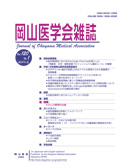

Journal of Okayama Medical Association
Published by Okayama Medical Association<Availability>
Full-text articles are available 3 years after publication.
Permalink : http://escholarship.lib.okayama-u.ac.jp/19360
結核感染動物の生体内に発生する溶血性物質に関する研究 第2編 結核感染動物の臓器より抽出した溶血性物質の精製
小林 実
岡山大学医学部病理学教室
発行日
1958-12-31
抄録
In the first paper the author reported that in the course of tnberculous infection a fairly large quantity of hemolytic substances were produced in the organs, especially in lymph nodes and spleen. In this paper the author reports the studies on the chemical nature of them. Dissolving the browhish viscous stbstance from the aceton insoluble fraction in pure ethanol, the substance was precitated as the Cd-salt by adding cadomium chloride solution. Precipitant was dissolved in chloroform and removed Cd by centrifugation after adding ammonium alcohol. The supernatant was dried and dissolved in pure ethanol. By drying again under a low pressure white needle-like crystals have been obtained. This substance proved to hemolyze completely the rabbit erythrocytes suspended in the saline solution in the concentration of 55 × 10⁻⁵ % . Comparing these crystal forms, hemolytic activity and the solubility in the organic solvents with those of the pure lysolecithin obtained from the rice grain, it is proved that these hemolytic substances are nothing but lysolecthin. The substance from the aceton soluble fraction is fatty acids produced by the decomposition of lecithin.
ISSN
0030-1558
NCID
AN00032489
